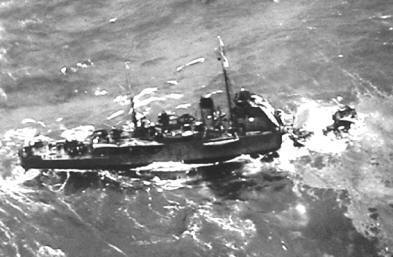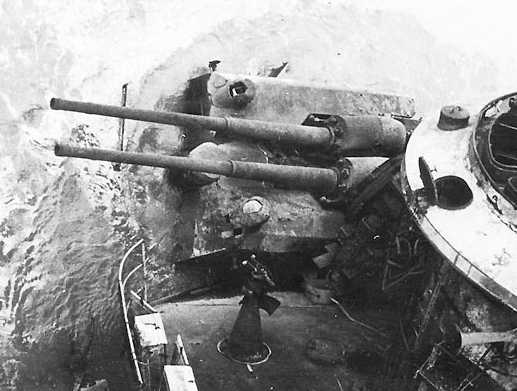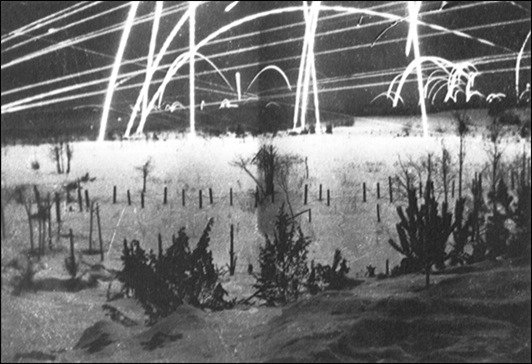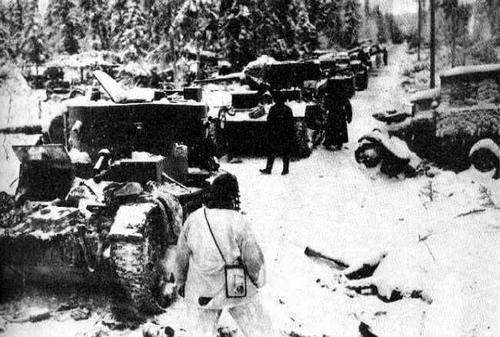Monday 5 February 1940
Winter War Army Operations: On 5 February 1940, Soviet 7th and 13th Armies continue attacking the Mannerheim Line. The Soviets are not advancing, but they are not trying yet. For now, they are weakening the Finnish Mannerheim line in aid of a breakthrough at a later point.
Winter War Air Operations: Soviet air raids continue. The monastery of Valamo on Lake Ladoga is among the places hit, as well as churches.
Winter War Peace Talks: Secret peace talks continue between the Finnish Foreign Minister and Madame Kollontai, the Soviet ambassador to Sweden.
Battle of the Atlantic: U-41 (Kapitänleutnant Gustav-Adolf Mugler) torpedoes Dutch tanker Ceronia which is damaged but makes it to port. It then sinks British freighter SS Beaverburn 150 miles south of Ireland. There are 76 survivors and one crew perishes
U-41 then attacks Convoy OA-84 south of Ireland without success. Instead, U-41 itself is sunk by depth charges by the destroyer HMS Antelope. Antelope's Captain, Lt. Commander White, wins the DSO for this first sinking by a solitary destroyer. There are no survivors of the U-boat.
US freighter Exford is detained by the British at Gibraltar.
Convoy OA 86 departs from Southend, Convoy SL 19F departs from Freetown.
Supreme Allied War Council: The fifth meeting takes place in Paris. A decision is taken to intervene in the Winter War first by sending aircraft and guns to Finland. The tentative plan thereafter is to stage landings at Narvik and other ports about 20 March 1940. After that, the troops would proceed by rail through Sweden to Finland. The Allied troops not only would seize the Norwegian iron ore mines, but also secure the Swedish mines.
This assumes Swedish and Norwegian acquiescence in the plan. Germany, of course, is making similar plans, but they are not relying on the kindness of anyone. The Allied plan makes little sense, envisioning using only two divisions (against the entire Soviet army) that do not even exist yet or would have to be diverted from the BEF in France. It appears calculated more to suppress Norwegian and Swedish iron ore delivers to Germany and to coerce Norway to the Allied side than to aid Finland.
British Chief of Staff General Sir Edmund Ironside writes afterward that everyone is "purring with pleasure" at this chance to go into action. BEF Chief of Staff General Henry Pownall, though, is not so pleased, writing in his own diary:
British Military: General Percival becomes commander of 43rd Infantry Division.
US Government: The US Maritime Commission announces that Britain and France, in great need of shipping, are purchasing 113,000 tonnes of American cargo ships.
China: In the Battle of South Kwangsi, the Japanese attack Wuning.
February 2, 1940: Soviet Assaults at Summa February 3, 1940: Soviets Capture a Bunker
February 4, 1940: Peace Talks in Stockholm
February 5, 1940: Allies to Invade Norway
February 6, 1940: Careless Talk Costs Lives
February 7, 1940: IRA Terrorists Executed
February 8, 1940: Spies!
February 9, 1940: The Welles Mission
February 10, 1940: Confiscation of Jewish Goods
February 11, 1940: Soviets Attack Mannerheim Line
February 12, 1940: Breaches In Mannerheim Line
February 13, 1940: Soviets Inching Forward in Finland
February 14, 1940: Soviets Batter Mannerheim Line
February 15, 1940: Finns Retreat
February 16, 1940: Altmark Incident
February 17, 1940: Manstein and Hitler Discuss Fall Gelb
February 18, 1940: Operation Nordmark
February 19, 1940: King Gustav Says No
February 20, 1940: Falkenhorst Commands Weserubung
February 21, 1940: Radar Advances
February 22, 1940: Friendly Fire
February 23, 1940: Soviets Present Their Demands
February 24, 1940: Fall Gelb Revised
February 25, 1940: Mr. Welles Comes to Visit
February 26, 1940: Battle of Honkaniemi
February 27, 1940: Finns Retreat Again
February 28, 1940: Overseas Volunteers Help Finland
February 29, 1940: Finns Accept Soviet Terms In Principle
2019
Winter War Air Operations: Soviet air raids continue. The monastery of Valamo on Lake Ladoga is among the places hit, as well as churches.
Winter War Peace Talks: Secret peace talks continue between the Finnish Foreign Minister and Madame Kollontai, the Soviet ambassador to Sweden.
Battle of the Atlantic: U-41 (Kapitänleutnant Gustav-Adolf Mugler) torpedoes Dutch tanker Ceronia which is damaged but makes it to port. It then sinks British freighter SS Beaverburn 150 miles south of Ireland. There are 76 survivors and one crew perishes
U-41 then attacks Convoy OA-84 south of Ireland without success. Instead, U-41 itself is sunk by depth charges by the destroyer HMS Antelope. Antelope's Captain, Lt. Commander White, wins the DSO for this first sinking by a solitary destroyer. There are no survivors of the U-boat.
US freighter Exford is detained by the British at Gibraltar.
Convoy OA 86 departs from Southend, Convoy SL 19F departs from Freetown.
Supreme Allied War Council: The fifth meeting takes place in Paris. A decision is taken to intervene in the Winter War first by sending aircraft and guns to Finland. The tentative plan thereafter is to stage landings at Narvik and other ports about 20 March 1940. After that, the troops would proceed by rail through Sweden to Finland. The Allied troops not only would seize the Norwegian iron ore mines, but also secure the Swedish mines.
This assumes Swedish and Norwegian acquiescence in the plan. Germany, of course, is making similar plans, but they are not relying on the kindness of anyone. The Allied plan makes little sense, envisioning using only two divisions (against the entire Soviet army) that do not even exist yet or would have to be diverted from the BEF in France. It appears calculated more to suppress Norwegian and Swedish iron ore delivers to Germany and to coerce Norway to the Allied side than to aid Finland.
British Chief of Staff General Sir Edmund Ironside writes afterward that everyone is "purring with pleasure" at this chance to go into action. BEF Chief of Staff General Henry Pownall, though, is not so pleased, writing in his own diary:
“For five months we have been struggling to make fit for action in the Spring a force that was dangerously under-equipped and untrained. There were signs that we were getting some reasonable way to our goal. If this business [the invasion of Norway] goes through, we shall be cut by 30%. Of all the harebrained projects I have heard of, this is the most foolish.”Dutch Military: Commander-in-chief Izaak Reynders resigns effective on 6 February 1940. He is replaced by General Henri Winkelman. Reynders was disgraced by his intemperate reaction to the Mechelen Incident. The reason given is the lack of government support for increased defense expenditures.
British Military: General Percival becomes commander of 43rd Infantry Division.
US Government: The US Maritime Commission announces that Britain and France, in great need of shipping, are purchasing 113,000 tonnes of American cargo ships.
China: In the Battle of South Kwangsi, the Japanese attack Wuning.
February 1940
February 1, 1940: Second Battle of SummaFebruary 2, 1940: Soviet Assaults at Summa February 3, 1940: Soviets Capture a Bunker
February 4, 1940: Peace Talks in Stockholm
February 5, 1940: Allies to Invade Norway
February 6, 1940: Careless Talk Costs Lives
February 7, 1940: IRA Terrorists Executed
February 8, 1940: Spies!
February 9, 1940: The Welles Mission
February 10, 1940: Confiscation of Jewish Goods
February 11, 1940: Soviets Attack Mannerheim Line
February 12, 1940: Breaches In Mannerheim Line
February 13, 1940: Soviets Inching Forward in Finland
February 14, 1940: Soviets Batter Mannerheim Line
February 15, 1940: Finns Retreat
February 16, 1940: Altmark Incident
February 17, 1940: Manstein and Hitler Discuss Fall Gelb
February 18, 1940: Operation Nordmark
February 19, 1940: King Gustav Says No
February 20, 1940: Falkenhorst Commands Weserubung
February 21, 1940: Radar Advances
February 22, 1940: Friendly Fire
February 23, 1940: Soviets Present Their Demands
February 24, 1940: Fall Gelb Revised
February 25, 1940: Mr. Welles Comes to Visit
February 26, 1940: Battle of Honkaniemi
February 27, 1940: Finns Retreat Again
February 28, 1940: Overseas Volunteers Help Finland
February 29, 1940: Finns Accept Soviet Terms In Principle
2019

















